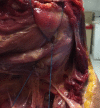Accuracy of Suture Passage During Arthroscopic Remplissage-What Anatomic Landmarks Can Improve It?: A Cadaveric Study
- PMID: 27606326
- PMCID: PMC4997326
- DOI: 10.1177/2325967116663497
Accuracy of Suture Passage During Arthroscopic Remplissage-What Anatomic Landmarks Can Improve It?: A Cadaveric Study
Abstract
Background: Recent data suggest that inaccurate suture passage during remplissage may contribute to a loss of external rotation, with the potential to cause posterior shoulder pain because of the proximity to the musculotendinous junction.
Purpose: To evaluate the accuracy of suture passage during remplissage and identify surface landmarks to improve accuracy.
Study design: Descriptive laboratory study.
Methods: Arthroscopic remplissage was performed on 6 cadaveric shoulder specimens. Two single-loaded suture anchors were used for each remplissage. After suture passage, position was recorded in reference to the posterolateral acromion (PLA), with entry perpendicular to the humeral surface. After these measurements, the location of posterior cuff penetration was identified by careful surgical dissection.
Results: Twenty-four sutures were passed in 6 specimens: 6 sutures (25.0%) were correctly passed through the infraspinatus tendon, 12 (50%) were through the infraspinatus muscle or musculotendinous junction (MTJ), and 6 (25%) were through the teres minor. Suture passage through the infraspinatus were on average 25 ± 5.4 mm inferior to the PLA, while sutures passing through the teres minor were on average 35.8 ± 5.7 mm inferior to the PLA. There was an odds ratio of 25 (95% CI, 2.1-298.3; P < .001) that the suture would be through the infraspinatus if the passes were less than 3 cm inferior to the PLA. Sutures passing through muscle and the MTJ were significantly more medial than those passing through tendon, measuring on average 8.1 ± 5.1 mm lateral to the PLA compared with 14.5 ± 5.5 mm (P < .02). If suture passes were greater than 1 cm lateral to the PLA, it was significantly more likely to be in tendon (P = .013).
Conclusion: We found remplissage suture passage was inaccurate, with only 25% of sutures penetrating the infraspinatus tendon. Passing sutures 1 cm lateral and within 3 cm inferior of the PLA improves the odds of successful infraspinatus tenodesis. We recommend this "safe zone" to improve the odds of infraspinatus tenodesis during remplissage. These results may help improve remplissage techniques and prevent previously reported complications, including external rotation loss and pain from myodesis.
Keywords: Hill-Sachs; anchors; remplissage; suture passage.
Conflict of interest statement
One or more of the authors has declared the following potential conflict of interest or source of funding: J.S.D. is a consultant for Arthrex.
Figures



Similar articles
-
Is arthroscopic remplissage a tenodesis or capsulomyodesis? An anatomic study.Knee Surg Sports Traumatol Arthrosc. 2016 Feb;24(2):573-7. doi: 10.1007/s00167-015-3756-8. Epub 2015 Aug 15. Knee Surg Sports Traumatol Arthrosc. 2016. PMID: 26275371
-
The "Safe Zone" Technique Improves Suture Placement and Accuracy During Arthroscopic Remplissage.Orthopedics. 2017 Jul 1;40(4):e598-e603. doi: 10.3928/01477447-20170411-05. Epub 2017 Apr 18. Orthopedics. 2017. PMID: 28418576
-
The Intra-articular "Wave Sign" as a Landmark for Suture Anchor Placement in Arthroscopic Remplissage.Orthopedics. 2017 Sep 1;40(5):e831-e835. doi: 10.3928/01477447-20170619-03. Epub 2017 Jun 30. Orthopedics. 2017. PMID: 28662251
-
[Arthroscopic treatment of Hill-Sachs lesions in glenohumeral instability. "Remplissage" technique].Acta Ortop Mex. 2014 Nov-Dec;28(6):382-8. Acta Ortop Mex. 2014. PMID: 26016292 Review. Spanish.
-
Arthroscopic technique for patch augmentation of rotator cuff repairs.Arthroscopy. 2006 Oct;22(10):1136.e1-6. doi: 10.1016/j.arthro.2006.03.022. Arthroscopy. 2006. PMID: 17027416 Review.
Cited by
-
Clinical and Image Outcomes of the Hill-Sachs Injury Approach by the Remplissage Technique on the Anterior Shoulder Instability.Rev Bras Ortop (Sao Paulo). 2019 Feb;54(1):13-19. doi: 10.1016/j.rbo.2017.10.010. Epub 2019 Mar 1. Rev Bras Ortop (Sao Paulo). 2019. PMID: 31363237 Free PMC article.
References
-
- Argintar E, Heckmann N, Wang L, Tibone JE, Lee TQ. The biomechanical effect of shoulder remplissage combined with bankart repair for the treatment of engaging Hill-Sachs lesions. Knee Surg Sports Traumatol Arthrosc. 2016;24:585–592. - PubMed
-
- Baker CL, Uribe JW, Whitman C. Arthroscopic evaluation of acute initial anterior shoulder dislocations. Am J Sports Med. 1990;18:25–28. - PubMed
-
- Boileau P, O’Shea K, Vargas P, Pinedo M, Old J, Zumstein M. Anatomical and functional results after arthroscopic hill-sachs remplissage. J Bone Joint Surg Am. 2012;94:618–626. - PubMed
-
- Buza I, John A, Iyengar JJ, Anakwenze OA, Ahmad CS, Levine WN. Arthroscopic hill-sachs remplissage. J Bone Joint Surg Am. 2014;96:549–555. - PubMed
-
- Chapovsky F, Kelly JD., 4th Osteochondral allograft transplantation for treatment of glenohumeral instability. Arthroscopy. 2005;21:1007. - PubMed
LinkOut - more resources
Full Text Sources
Other Literature Sources

